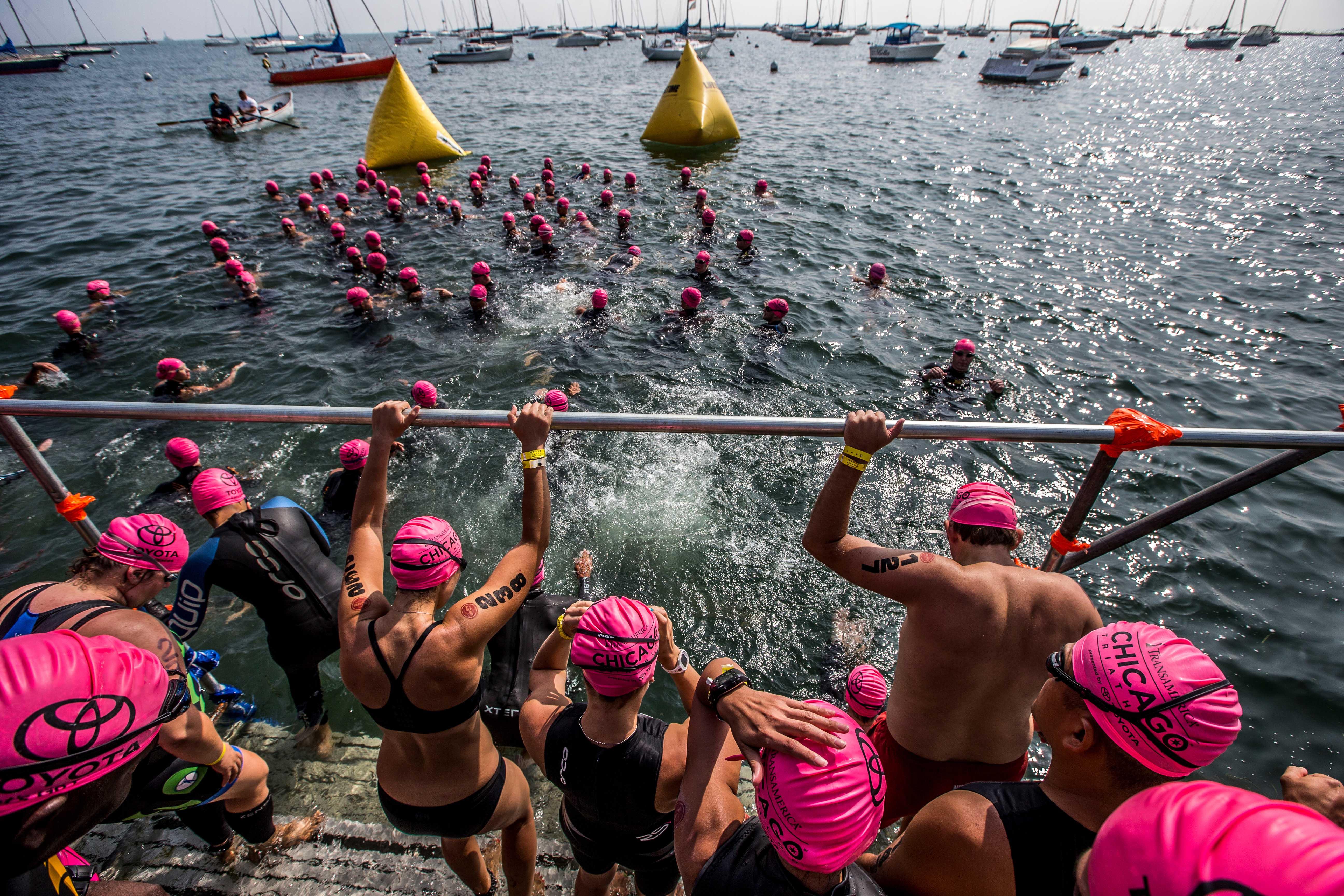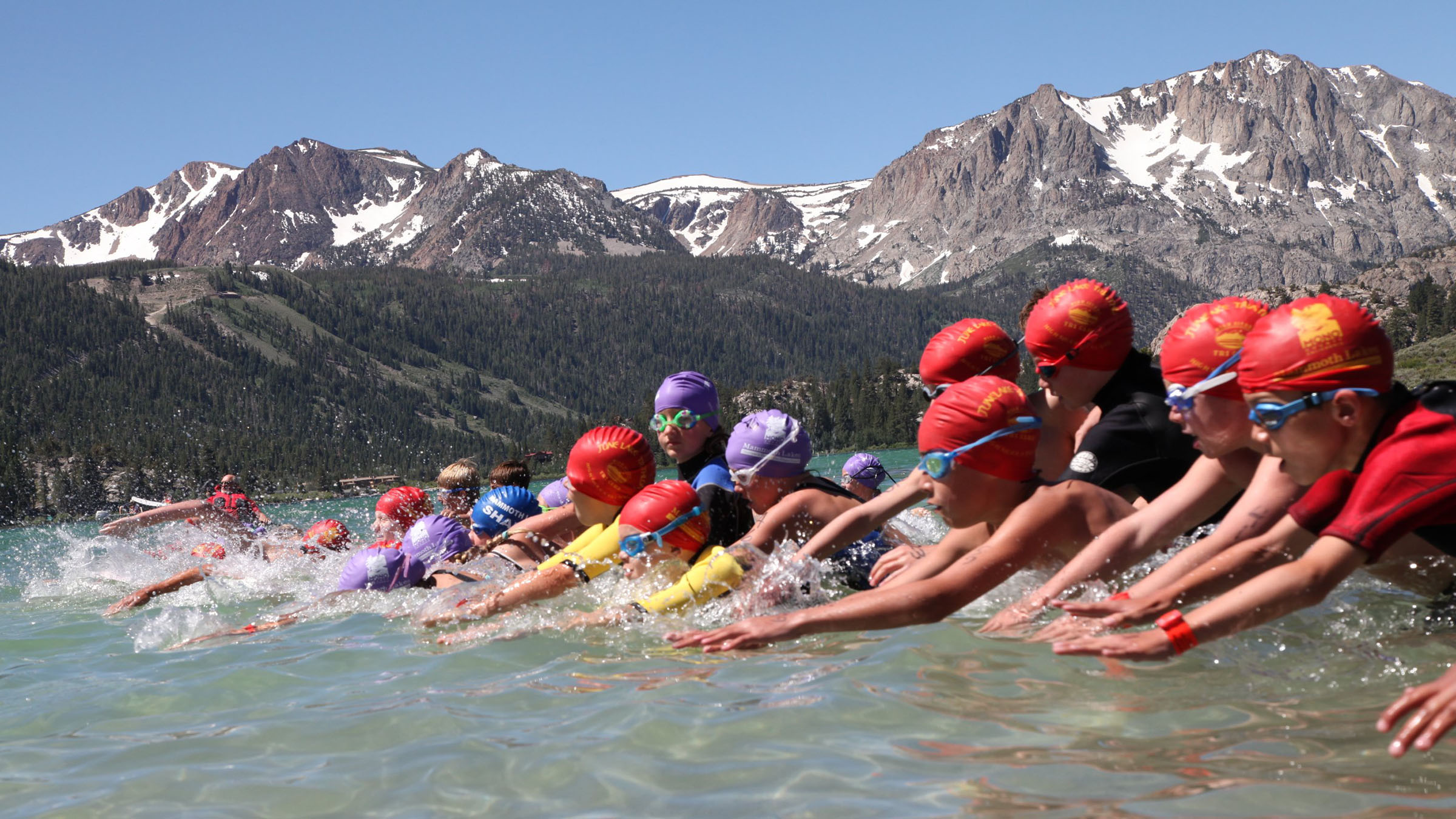Home>Misc>Featured>How Deep Is Lake Michigan Chicago Triathlon


Featured
How Deep Is Lake Michigan Chicago Triathlon
Modified: January 2, 2024
Experience the thrill of the Featured Lake Michigan Chicago Triathlon as you dive deep into the challenges of this iconic race.
Introduction
Welcome to the exhilarating world of the Chicago Triathlon, where athletes push their limits in a test of strength, endurance, and determination. This iconic event, held in the heart of the Windy City, attracts participants from all over the world, eager to compete in the challenging swim, bike, and run disciplines.
What sets the Chicago Triathlon apart from other triathlons is its unique location. The event takes place along the beautiful shoreline of Lake Michigan, one of the largest freshwater lakes in the world. The deep, clear waters of Lake Michigan provide an ideal backdrop for the swimming portion of the triathlon, offering athletes a thrilling and challenging experience.
In this article, we will delve into the fascinating depths of Lake Michigan and explore just how deep this iconic lake is. We will examine the importance of Lake Michigan for the Chicago Triathlon and discuss the factors that can affect its depth. Additionally, we will take a closer look at the deep areas of the lake and consider their significance for the triathlon.
So, buckle up and prepare to dive into the depths of Lake Michigan, as we unravel the secrets that lie beneath the surface.
History of the Chicago Triathlon
The Chicago Triathlon has a rich history that dates back to 1983, making it one of the oldest triathlons in the United States. It was founded by Ray Smooth, who saw the potential of bringing the triathlon to the bustling city of Chicago. What started as a modest event with a few hundred participants has now grown into a world-renowned race that attracts thousands of athletes each year.
The inaugural Chicago Triathlon took place on August 28, 1983, with only 50 athletes competing in a single-distance race. Over the years, the event expanded to include various race categories, including sprint, Olympic, and international distances. It now encompasses a weekend of activities, including a triathlon expo and other community events.
The Chicago Triathlon has gained recognition as a premier sporting event, attracting both amateur and professional athletes from around the globe. Its scenic and picturesque course, combined with the electric atmosphere created by the cheering crowds, has contributed to its popularity among participants and spectators alike.
Throughout its history, the Chicago Triathlon has witnessed remarkable achievements and memorable moments. From record-breaking times to inspiring comebacks, the race has become a platform for athletes to showcase their talent and dedication. It has also served as a qualifying event for prestigious competitions, such as the Ironman World Championship in Kona, Hawaii.
Over the years, the race has evolved and embraced advancements in technology and safety measures. The addition of chip timing systems, improved swim start procedures, and enhanced course management has made the Chicago Triathlon a more seamless and enjoyable experience for athletes.
Each edition of the Chicago Triathlon brings its own unique stories and triumphs, further solidifying its place in the storied history of the sport. As athletes continue to push their limits and strive for personal bests, the Chicago Triathlon will undoubtedly remain an iconic event in the world of triathlon for years to come.
Overview of Lake Michigan
Lake Michigan, one of the five Great Lakes of North America, is a vast body of freshwater that stretches along the eastern shore of the United States. It is the third-largest Great Lake by volume and the second-largest by surface area, covering approximately 22,400 square miles.
The lake is situated between the states of Michigan, Indiana, Illinois, and Wisconsin, with the bustling city of Chicago nestled along its southwestern coast. Its strategic location and accessibility have made it a popular destination for recreational activities and a vital resource for the surrounding communities.
Lake Michigan boasts a stunning coastline that spans around 1,640 miles, offering picturesque views and endless opportunities for water-based adventures. From sandy beaches and dunes to rugged cliffs and lush forests, the diverse landscapes around the lake provide a unique and breathtaking backdrop for outdoor enthusiasts.
The lake itself is renowned for its crystal-clear waters, with visibility often exceeding 25 feet in ideal conditions. This clarity is due in part to the absence of significant algae blooms, which can cloud the water in other lakes. The pristine nature of Lake Michigan’s waters makes it a popular destination for swimming, boating, fishing, and other water sports.
As a significant freshwater resource, Lake Michigan plays a crucial role in the region’s ecosystem and economy. It supports a thriving commercial and recreational fishing industry, providing a source of sustenance and livelihood for countless communities. Additionally, the lake serves as a source of drinking water for millions of people in the surrounding areas.
With its impressive size, stunning scenery, and vital importance to the region, Lake Michigan has become a cherished natural asset. It offers a tranquil escape from the bustling cityscape of Chicago and a playground for outdoor enthusiasts to explore and enjoy.
Importance of Lake Michigan for the Chicago Triathlon
Lake Michigan plays a significant role in the Chicago Triathlon, as it serves as the backdrop for the thrilling and challenging swimming portion of the race. The presence of this magnificent body of water adds a unique element to the event, attracting athletes from all over the world to compete in its inviting yet formidable depths.
Swimming in Lake Michigan presents a distinct set of challenges and excitements that set the Chicago Triathlon apart from other triathlons. The freshwater lake offers a refreshing and buoyant environment for athletes, allowing them to glide through the water with ease. The absence of heavy currents and tides, typically found in saltwater bodies, provides a more predictable and controlled swimming experience.
Furthermore, Lake Michigan’s size and depth demand a high level of endurance and skill from participants. Athletes must navigate the expansive water while maintaining their pace and direction, battling both physical and mental fatigue. The vastness of the lake can be both awe-inspiring and intimidating, making it a true test of the triathletes’ determination and resilience.
The importance of Lake Michigan extends beyond the physical challenges it presents. The lake’s iconic presence adds a sense of grandeur and excitement to the race. As athletes dive into its emerald waters and swim towards the Chicago skyline, they become part of a unique and memorable experience that is deeply intertwined with the identity of the Chicago Triathlon.
For participants and spectators alike, the opportunity to witness the convergence of athleticism and natural beauty is truly captivating. The sight of swimmers battling the waves against the backdrop of the city skyline creates an awe-inspiring spectacle that brings a sense of unity and admiration to the competition.
Moreover, the experience of swimming in Lake Michigan leaves a lasting impression on participants. The memories forged during the race, the exhilaration of conquering the deep waters, and the camaraderie shared with fellow triathletes form an indelible bond that connects them to the lake and the event for years to come.
Overall, Lake Michigan’s significance for the Chicago Triathlon cannot be overstated. It not only provides a dynamic and challenging swimming environment but also serves as a symbol of the race’s unique allure. The deep waters of Lake Michigan stand as a testament to the tenacity and determination of the athletes, making the Chicago Triathlon a standout event in the world of triathlon.
Measurement of Lake Michigan’s Depth
Measuring the depth of a lake as vast as Lake Michigan is no simple task. Over the years, various methods have been employed to determine the depths of this magnificent body of water, providing valuable insights into its geological and hydrological characteristics.
The most common method used to measure the depth of Lake Michigan is bathymetry, which involves the use of specialized equipment to map the contours of the lake floor. Bathymetric surveys utilize echo-sounding technology, which sends sound waves to the lake bottom and measures the time it takes for the waves to bounce back. By analyzing these data, scientists can create detailed depth charts and three-dimensional representations of the lake’s underwater topography.
Another method used to measure the lake’s depth is the use of submersible vehicles equipped with sonar systems. These vehicles, such as remotely operated underwater vehicles (ROVs) and autonomous underwater vehicles (AUVs), can navigate the depths of Lake Michigan and collect high-resolution sonar data. This information allows researchers to gain a better understanding of the lake’s bathymetry, including the presence of underwater features like ridges, basins, and canyons.
Through these methods, scientists have been able to determine that the average depth of Lake Michigan is around 279 feet (85 meters). However, the lake’s depth can vary significantly in different areas. Along the eastern shore, depths can reach up to 923 feet (281 meters) in some locations, while the western shore tends to be shallower, with depths ranging from 100 to 300 feet (30 to 91 meters). The sheer size of the lake, stretching over 307 miles (494 kilometers) from north to south, contributes to this variation in depth.
It’s important to note that Lake Michigan’s depth is not fixed and can fluctuate due to natural processes such as erosion, sedimentation, and water level changes. Factors such as wind patterns, lake currents, and seasonal variations can impact the movement of sediment and influence the overall depth of the lake.
In recent years, advancements in technology have allowed for more precise and detailed measurements of Lake Michigan’s depths. These measurements provide valuable data for scientists, government agencies, and recreational boaters alike, enabling better understanding and management of this magnificent freshwater resource.
Factors Affecting the Depth of Lake Michigan
Several factors contribute to the varying depths of Lake Michigan, shaping its underwater landscape and creating a diverse and dynamic aquatic environment. These factors can influence the depth of the lake in different ways, from natural processes to human activities.
One of the primary factors affecting the depth of Lake Michigan is the geology of the region. The lake’s formation is a result of glaciation during the last Ice Age, which sculpted the land and created depressions that later became the Great Lakes. The depth of Lake Michigan is influenced by these glacial features, such as basins, ridges, and valleys, which shape the lake’s underwater topography.
The hydrological cycle, including precipitation and evaporation, also plays a role in determining the depth of Lake Michigan. Higher levels of precipitation in the surrounding watershed can increase water inflow into the lake, leading to higher water levels and potentially affecting its depth. Conversely, increased evaporation rates can result in lower water levels, affecting the overall depth of the lake in certain areas.
Wind patterns and lake currents are another significant factor influencing the depth of Lake Michigan. Strong winds can cause water to pile up on one side of the lake, creating waves and affecting the water level. These wind-driven currents can cause sediment movement, leading to erosion in some areas and deposition in others. Over time, these processes can shape the lake’s depth and create underwater features.
Human activities, such as dredging and dredge spoil disposal, can also impact the depth of Lake Michigan. Dredging involves the removal of sediment from the lake bottom to maintain navigational channels or create harbor facilities. Disposal of dredged material can alter the underwater landscape, potentially deepening certain areas while reducing depths in others.
Climate change is a growing concern that may affect the future depths of Lake Michigan. Rising temperatures and changes in precipitation patterns can influence evaporation rates, altering water levels and potentially impacting the depth of the lake. Additionally, shifts in wind patterns and currents due to climate change can lead to changes in sediment movement, influencing the underwater topography.
It is crucial to monitor and understand the factors affecting the depth of Lake Michigan to ensure the sustainability and health of this vital freshwater resource. By studying these factors, scientists, policymakers, and stakeholders can make informed decisions to protect and manage the lake for future generations.
Exploration of Lake Michigan’s Deep Areas
Exploring the deep areas of Lake Michigan unveils a mesmerizing underwater world that is both mysterious and captivating. Over the years, scientists and researchers have ventured into the depths of this vast freshwater lake, uncovering fascinating geological formations and discovering diverse aquatic ecosystems.
One of the most intriguing deep areas of Lake Michigan is the Chippewa Basin, located near the northern part of the lake. With depths reaching up to 923 feet (281 meters), it is one of the deepest points in the entire Great Lakes system. This basin is the result of ancient volcanic activity, which has shaped the underwater landscape and created a unique habitat for various species.
Exploration of Lake Michigan’s deep areas has also revealed the presence of underwater canyons, such as the Milwaukee Deep. Extending over 900 feet (274 meters) below the lake’s surface, this submerged canyon showcases the dynamic geological history of the region. These canyons provide important habitats for a wide range of organisms, including fish, invertebrates, and even rare deepwater corals.
The deep areas of Lake Michigan are home to a diverse array of species, adapted to survive in the cool and dark underwater environment. Fish species such as lake trout, Chinook salmon, and deepwater sculpin are found in these depths, taking advantage of the rich food sources and the protection provided by deepwater habitats.
Exploration efforts have been facilitated by the use of advanced technology, including remotely operated underwater vehicles (ROVs) and autonomous underwater vehicles (AUVs). These vehicles can navigate the depths of Lake Michigan, capturing high-resolution images and collecting data on the underwater ecosystems. This information is invaluable for understanding the unique biodiversity and ecological functioning of the deep areas of the lake.
While exploration of Lake Michigan’s deep areas continues to provide valuable insights, it is important to balance scientific curiosity with preservation. Careful management is necessary to ensure the conservation of these deepwater habitats and the species that rely on them. By promoting sustainable practices and protecting these fragile ecosystems, we can maintain the ecological balance of Lake Michigan and preserve its deep areas for future generations to explore and appreciate.
Significance of Lake Michigan’s Depth for the Chicago Triathlon
The depth of Lake Michigan holds great significance for the Chicago Triathlon, impacting the race experience for participants and adding an element of challenge and excitement to the event. Understanding the depth of the lake is essential for race organizers and athletes to prepare appropriately and ensure a safe and enjoyable competition.
The depth of Lake Michigan influences several aspects of the swimming portion of the Chicago Triathlon. The deep waters of the lake create a unique and demanding environment that tests the endurance and skill of the participants. By navigating through the depths of the lake, triathletes must adapt to the changing conditions and overcome the physical and mental challenges it presents.
The depth of Lake Michigan also affects water temperature. Deeper areas of the lake tend to have cooler temperatures compared to shallow areas. This variation in temperature can impact swimmers and require them to adjust their strategies and preparations accordingly. Athletes must consider the potential impact of cooler water on their performance and ensure they have adequate wetsuits or thermal gear to maintain comfort and optimal body temperature.
In addition, the depth of the lake plays a role in shaping the racecourse. The swim portion of the Chicago Triathlon is designed to take advantage of the lake’s unique features, incorporating buoy markers that guide participants through various depths. Athletes must navigate the course, accounting for changes in water depth, elevation, and underwater topography. Understanding the lake’s depth allows course designers to create a challenging and engaging swim course that showcases the natural beauty of Lake Michigan.
The depth of Lake Michigan also adds to the overall excitement and allure of the Chicago Triathlon. The sheer size and depth of the lake create a sense of grandeur and spectacle, enhancing the unique experience for both participants and spectators. The sight of swimmers battling the waves amidst the expansive depth of Lake Michigan adds an element of awe and adventure to the race, making it an unforgettable event.
Moreover, the depth of Lake Michigan allows for a larger number of participants to compete simultaneously. The vastness of the lake provides ample space for athletes to spread out during the swim portion, reducing congestion and ensuring a smoother and safer experience for everyone involved.
Ultimately, the depth of Lake Michigan is a defining characteristic of the Chicago Triathlon, shaping the race experience and adding to its prestige. It challenges athletes, highlights the natural beauty of the lake, and creates a memorable event that continues to attract participants from all over the world.
Conclusion
The depth of Lake Michigan is an integral part of the Chicago Triathlon, contributing to the uniqueness and allure of this iconic event. The deep, clear waters of the lake provide a thrilling and challenging swimming experience for participants, testing their endurance and skills.
As one of the largest freshwater lakes in the world, Lake Michigan offers a stunning backdrop for the race, with its expansive shoreline and picturesque views. Its significance for the triathlon extends beyond the physical challenges it presents, as it adds a sense of grandeur and excitement to the event.
Understanding the depth of Lake Michigan is crucial for race organizers and participants. It influences various aspects of the triathlon, from water temperature considerations to course design. The deep areas of the lake provide athletes with a unique opportunity to immerse themselves in the depths, showcasing their determination and resilience.
Exploration of Lake Michigan’s deep areas has unveiled a captivating underwater world, with remarkable geological formations and diverse ecosystems. The deep waters are home to a multitude of species, adding to the ecological richness of the lake.
Appreciating the significance of Lake Michigan’s depth helps us understand the remarkable connection between nature and sport. It highlights the harmonious blend of physicality, beauty, and challenge that makes the Chicago Triathlon a standout event in the world of triathlon.
In the end, Lake Michigan remains an exceptional natural asset, providing a stunning venue for the Chicago Triathlon. Its depth serves as a testament to the strength and determination of the athletes, as they conquer the deep waters in their pursuit of victory.
As the race continues to captivate participants and spectators year after year, Lake Michigan will forever hold its place at the heart of the Chicago Triathlon, ensuring its legacy as a premier and unforgettable event in the triathlon community.









